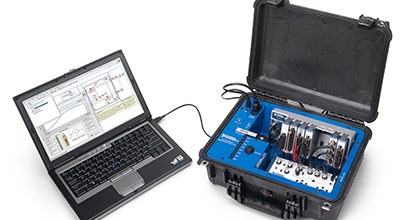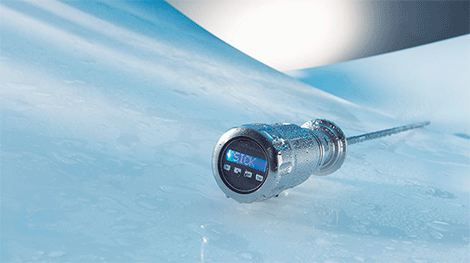heat measurement
Depending on the application, temperature sensors have to meet very different requirements, for example with regard to measurement accuracy, temperature resistance and size. In the case of contact measurement techniques, it is often possible to replace expensive special sensors with cheaper NTCs.
NTC SMD element
Temperature measurement is one of the most important disciplines of sensory technology. Fundamentally, a difference is made between non-contact and contact measurement techniques. This article deals exclusively with contact temperature measurement in which the sensor element is in thermal contact with the measurement object. The most important sensor elements are temperature dependent resistors which are divided into NTC (Negative Temperature Coefficient) and PTC (Positive Temperature Coefficient) groups, based on silicon, barium titanate or pure platinum). NTCs conduct electrical current better at high temperatures than at low ones, while PTCs show the opposite behavior. In contrast to NTCs, PTCs generally show a linear RT characteristic curve. However, the advantages offered by NTCs are the possibility of variably adapting the electrical parameters and their low price. NTCs are characterized by a few parameters: to a first approximation, the resistance of a NTC behaves as an exponential function: R(T) = R25 exp [B (1/T – 1/T25)] (1) where T25 = 298,15 K, T: temperature in K. R25 indicates the value of the resistance at the reference temperature of 25 °C. The so-called B value (in K) describes the behavior between resistance and temperature and determines the shape of the exponential function curve: B = T x T25/T25-T in R/R25 (2) For most applications, the Equation 1 provides a suitably good mathematical description of the behavior of resistance as a function of temperature. If high precision is required over a wide temperature range, the exponents of the equation can be considered as higher powers of temperature with a respective coefficient B1, B2, B3, etc. This is the so-called Steinhart-Hart equation with the Steinhart-Hart coefficients Bi. If necessary, these coefficients can be consulted with the manufacturers. The current required to measure the resistance, and with it the temperature, must be selected as low as possible in order to keep the inexorable self-heating of the NTC as low as possible. The data sheets refer to the so-called dissipation factor, which indicates the electrical power that heats the thermistor by 1°C compared to the ambient temperature. In practice it is advisable to stay well below this power. Finally, in an NTC, the time it takes to adopt the new resistance value after a temperature increase must be observed. In general, the time constant ô indicates the time after which the resistance has reached 63,2 percent of the final value.
thick film under glass
Especially in applications requiring high precision, the long-term stability of the sensor is an important factor, since what use would an initially low tolerance and thus a minimal measurement error be if the resistance value deviates with time? The primary cause of drift in ceramic components is moisture penetrating the component. This occurrence can be prevented with an enveloping glass passivation. Manufacturer Tateyama's thick-film SMD thermistors are built on a ceramic substrate (96 percent Al2O3), and the thick-film is protected against moisture with a layer of glass (Fig. 1). In this way, a very high mechanical resistance and reliability are also achieved. The advantage of these thick-film sensors lies in the variable adaptation of the R25 – (100 Ω to 2 M Ω) and B values (2.700 to 5.00 K) as well as the corresponding tolerances (±1 to ±10 percent) enabled by Tateyama's proprietary manufacturing technology. All of these SMD thermistors are certified to TS16949/AEC-Q standard and available in sizes 0805 to 0201. Due to the price level and long-term stability, these thermistors are used in applications such as HVAC systems, energy cost distributors, heating, appliances or power tools. Thick film technology can be used at temperatures up to 150°C. The smaller the format, the smaller the thermal mass and thus the time constant ô. For this reason, in applications where the temperature varies rapidly, small formats should be used if possible, preferably the 0201 format. The NTC series from the manufacturer Semitec are not based on thick-film technology, but on ceramic semiconductor technology. (Fig.2). They are characterized by a low tolerance (±1 percent in B and R25). The sensor with the minimum tolerance corresponds to the "AP" series (±0,5 percent in B and R25), which in a temperature range of -50 to +70 °C allows temperature measurements with a precision greater than 0,5 .0,5K, without the need to calibrate the system. Ultra-thin “Kapton film” NTCs with a thickness of only 4 mm are mainly used in batteries. The “KT” series corresponds to the Semitec SMD thermistor. Despite its low price, KT exhibits excellent long-term stability which is due to the crystal passivation of all four air-exposed surfaces of the ceramic chip. This constitutes a fundamental criterion in the current electronic distributors of heating costs, which must measure reliably for a period of ten years without the need to recalibrate. The use of the "AT-6,8" series is widespread in machine tools. Here, in particular, the XNUMX Ω model is used to monitor the temperature of the electronic control or the battery during the charging phase.
Maximum precision with nanoparticles
Temperature sensors from the manufacturers EXA-Thermometrics and Tewa complete the product offering with ready-made sensors. Thanks to the in-house development and manufacturing of NTC chips, a large selection of R25 and B values is possible depending on the requirements of the application. This is achieved by mixing suitable nanoparticles before the sintering process. During the cutting and rectifying process (dicing), the wafers are separated into chips (dies) and calibrated for the subsequent production process. The precision achieved here is better than ±0,05 percent. In this way, the precision of these sensors is produced consciously, and not only achieved with the help of a selection process. These chips generally form the base product for ready-made sensors. In certain cases, disc-shaped or glass-enclosed NTC chips as well as Pt elements (Pt100 – Pt1000) are also used as sensor chips. These chips are assembled with special cables (PVC, Teflon, Kynar, Halogen Free, Food Grade, UL Listed, etc.) and application-specific plug-in connections. Sensors for use in refrigerators and freezers are double insulated with a special composition of insulating materials. In this way, the IP68 protection index is guaranteed, and the sensor is suitable for food products. Other sensor variants with stainless steel, copper, brass or plastic housings are also possible according to customer specifications (Fig. 3). The upper limit of the service temperature of these assembled sensors can be up to approximately 500 °C.







